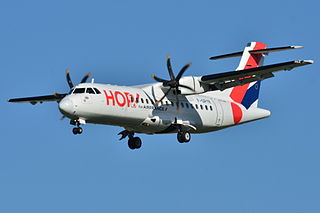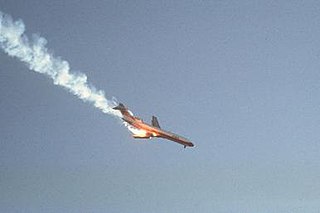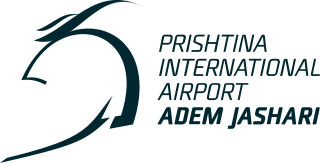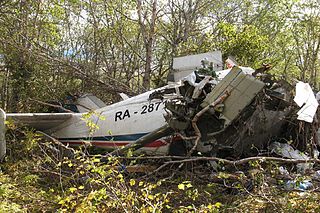
The ATR 42 is a regional airliner produced by Franco-Italian manufacturer ATR, with final assembly in Toulouse, France. On 4 November 1981, the aircraft was launched with ATR, as a joint venture between French Aérospatiale and Aeritalia . The ATR 42-300 performed its maiden flight on 16 August 1984 and type certification was granted during September 1985. Launch customer Air Littoral operated its first revenue-earning flight in December of that year.

Pacific Southwest Airlines Flight 182 was a scheduled flight of Pacific Southwest Airlines (PSA) from Sacramento to San Diego with a Stopover at Los Angeles. On September 25, 1978, the Boeing 727-214 serving the flight, registration of N533PS, collided with a private Cessna 172 light aircraft, registration N7711G, over San Diego, California. It was Pacific Southwest Airlines' first fatal accident, and it remains the deadliest air disaster in California history. At the time, it was the deadliest air crash to occur in the United States, and remained so until American Airlines Flight 191 crashed in May 1979.

Crossair Flight 3597 was a scheduled flight from Berlin Tegel Airport, Germany, to Zürich Airport, Switzerland. On 24 November 2001, the Crossair Avro RJ100 operating the route, registered as HB-IXM, crashed into a wooded range of hills near Bassersdorf and caught fire. Out of the 33 occupants, nine made it out alive.

Pilot error generally refers to an accident in which an action or decision made by the pilot was the cause or a contributing factor that led to the accident, but also includes the pilot's failure to make a correct decision or take proper action. Errors are intentional actions that fail to achieve their intended outcomes. The Chicago Convention defines the term "accident" as "an occurrence associated with the operation of an aircraft [...] in which [...] a person is fatally or seriously injured [...] except when the injuries are [...] inflicted by other persons." Hence the definition of "pilot error" does not include deliberate crashing.

The Adem Jashari Prishtina International Airport , also referred to as Pristina International Airport, is an international airport in Pristina, Kosovo. The airport is located 15 km (9.3 mi) southwest of the city of Pristina, Kosovo. The airport has flights to numerous European destinations.

Armavia Flight 967 was a scheduled international passenger flight operated by Armavia from Zvartnots International Airport, Zvarnots in Armenia to Sochi, a Black Sea coastal resort city in Russia. On 3 May 2006, the aircraft operating the route, an Airbus A320-200, crashed into the sea while attempting a go-around following its first approach to Sochi airport; all 113 aboard were killed. The accident was the first major commercial airline crash in 2006. It was Armavia's only fatal crash during the airline's existence.

Thai Airways International Flight 311 (TG311/THA311) was a flight from Bangkok, Thailand's Don Mueang International Airport to Kathmandu, Nepal's Tribhuvan International Airport. On Friday, 31 July 1992, an Airbus A310-304 on the route, registration HS-TID, crashed on approach to Kathmandu. At 07:00:26 UTC, the aircraft crashed into the side of a mountain 37 kilometres (23 mi) north of Kathmandu at an altitude of 11,500 ft (3,505 m) and a ground speed of 300 knots, killing all 113 passengers and crew members on board. This was both the first hull loss and the first fatal accident involving the Airbus A310.

Garuda Indonesia Flight 152 (GA152/GIA152) was a scheduled domestic flight operated by Garuda Indonesia from Soekarno-Hatta International Airport, Tangerang, to Polonia International Airport, Medan, in Indonesia. On 26 September 1997, the aircraft flying the route crashed into mountainous woodlands near the village of Buah Nabar, Sibolangit, killing all 222 passengers and 12 crew members on board. It is the deadliest aviation disaster in Indonesia's history.

Progress Multi Trade Air Flight 241 was a scheduled domestic passenger flight from Siem Reap to Sihanoukville, Cambodia. The flight was operated by regional airliner PMTair using an Antonov An-24. On 25 June 2007, the Antonov An-24, registered as XU-U4A, disappeared over the Cambodian jungle near Bokor Mountain in Kampot while on approach to Sihanoukville. A massive search and rescue operation ensued with thousands of soldiers and police scoured the area. The aircraft was found to have crashed in southwestern Cambodia, northeast of Dâmrei Mountains. All 22 people on board, most of whom were South Korean tourists, were killed. It remains as the second deadliest air disaster in Cambodian history.

Air Inter Flight 148 was a scheduled passenger flight from Lyon Satolas Airport to Strasbourg Airport in France. On 20 January 1992, the Airbus A320 operating the flight crashed into the slopes of the Vosges Mountains, France, near Mont Sainte-Odile, while on a non-precision approach at Strasbourg Airport. Eighty-seven of the 96 people on board were killed, while the remaining nine were all injured.

Inex-Adria Aviopromet Flight 1308 was a McDonnell Douglas MD-81 aircraft operating a Yugoslavian charter flight to the French island of Corsica. On 1 December 1981, the flight crashed on Corsica's Mont San-Pietro, killing all 180 people on board. The crash was the deadliest and first major aviation accident involving a McDonnell Douglas MD-80.

Indian Airlines Flight 257 was an Indian Airlines domestic passenger flight operating on the Calcutta–Imphal–Dimapur route. On 16 August 1991, the Boeing 737-2A8 registered VT-EFL crashed into the hilly terrain of Thangjing Hill during its descent, killing all 63 passengers and 6 crew members on board.

Atlasjet Flight 4203 was a scheduled domestic passenger flight from Istanbul Atatürk Airport in Istanbul to Isparta Süleyman Demirel Airport in Isparta Province, Turkey. On 30 November 2007, the aircraft operating the flight – a McDonnell Douglas MD-83 which Atlasjet had leased from World Focus Airlines just five months before – crashed in the vicinity of Keçiborlu between the villages of Yenitepe and Çukurören while on approach, approximately 12 kilometres (7.5 mi) west of the destination airport. The flight had taken off from Istanbul at 00:51 EET with 50 passengers and 7 crew members on board. All 57 occupants perished in the accident.

Aerosvit Flight 241 (VV241/EW241) was a scheduled international passenger flight from the Ukrainian city of Odesa to Thessaloniki, Greece. On 17 December 1997, the Yakovlev Yak-42 operating the flight registered as UR-42334 flew into a mountainside during a missed approach into Thessaloniki in Greece. All 70 people aboard were killed.

Airblue Flight 202 was a scheduled Pakistani domestic passenger flight from Karachi to the nation's capital of Islamabad. On 28 July 2010, the Airbus A321-231 jet airliner serving the flight crashed into Margalla Hills, north of Islamabad's Benazir Bhutto International Airport, killing all 146 passengers and six crew on board. It is the deadliest air accident to occur in Pakistan to date and the first fatal crash involving an Airbus A321.

On 12 September 2012 at about 12:20 local time, Petropavlovsk-Kamchatsky Air Flight 251, operated by an Antonov An-28, crashed while attempting to land at Palana Airport in Russia. Both pilots were killed, together with 8 of the 12 passengers. All 4 survivors were in serious condition. The aircraft descended below minima on approach in instrument meteorological conditions and impacted a forested slope. Alcohol was found in the blood of both flight crew.

TransAsia Airways Flight 222 was a scheduled domestic passenger flight operated by TransAsia Airways from Kaohsiung, Taiwan, to Magong, Penghu Island. On 23 July 2014, the ATR 72-500 twin turboprop operating the route crashed into buildings during approach to land in bad weather at Magong Airport. Among the 58 people on board, only 10 survived.

On May 21, 2000, a British Aerospace BAe-3101 Jetstream 3101 operated by East Coast Aviation Services crashed into mountainous terrain in Bear Creek Township, Wilkes-Barre, Pennsylvania. The plane was carrying 17 professional gamblers returning home from Caesar's Palace Casino in Atlantic City, New Jersey, along with 2 crew members. It was chartered by Caesar's Palace. All 19 passengers and crews on board were killed on impact. This accident, alongside the accident of Aerocaribe Flight 7831 were the accidents with the most fatalities involving the Jetstream 3101 airliner.

Iran Aseman Airlines Flight 3704 was a scheduled Iranian domestic passenger flight from Iranian capital Tehran Mehrabad International Airport to Yasuj in southwest Iran. On 18 February 2018, during its approach to Yasuj, the aircraft serving the flight, an ATR 72-212 operated by Iran Aseman Airlines, crashed into Mount Dena in the Zagros Mountains near Noqol village in Semirom county, Isfahan Province. All 66 people on board, including 60 passengers and 6 crew members, were killed.

Lufthansa Cargo Flight 527 was a Lufthansa Cargo flight scheduled to fly from Rio de Janeiro in Brazil to Dakar, the capital of Senegal. On 26 July 1979, shortly after take-off in Rio, the Boeing 707 flew into a slope and crashed. All 3 crew members, consisting of the captain, the first officer and a flight engineer died; there were no survivors. The principal cause of the crash was the failure of air traffic controllers to pay the necessary attention to each aircraft and ensure the necessary attention to rising terrain.




















